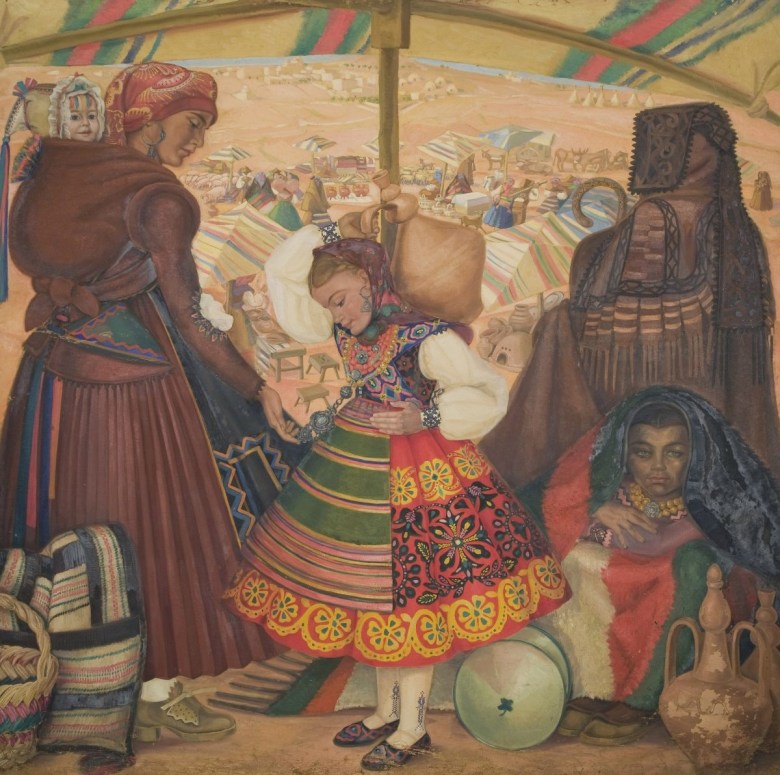VALLADOLID, Spain — The story of Spanish art in the 20th century has long been dominated by male artists working in abstraction. But a new wave of museum exhibitions in the country is shedding light on previously overlooked artists and modes, as is the case with Delhy Tejero. Geometría y misterio (Delhy Tejero. Geometry and Mystery) at the Museo Patio Herreriano de Arte Contemporáneo Español.
The extensive exhibition features more than 180 paintings, drawings, and other works from throughout the late Delhy Tejero’s career, speaking to her innovative approach to figuration. In addition, curator Patricia Molins presents preparatory sketches, archival materials, and examples of Tejero’s commercial work as a muralist and illustrator alongside her so-called fine art, giving visitors a wide and nuanced survey of her uniquely varied practice. Taken together, Tejero’s work embodies an alternative view of Spanish social and cultural life over the last century, one that privileges rural roots and an evolving feminist consciousness.
Born in the Zamoran town of Toro in 1904, the young artist moved to Madrid by herself in 1925, at the time a bold and uncommon step. In the capital city, Tejero studied at the Escuela de Artes y Oficios (where she would later work as a teacher) and at the prestigious Academia de Bellas Artes de San Fernando. Despite her classical academic training, she was part of the Generación del 27, a group of artists, poets, and writers — her fellow San Fernando peers Remedios Varo and Maruja Mallo among them — whose avant-garde work forged a new sense of Spanish identity through art from the late 1920s to early ’40s. Even Tejero’s fantastical, inventive illustration work for newspapers and books — a vital source of income throughout her life — reveals an early commitment to artistic experimentation.
Early in her career, Tejero pursued a women-centered regional art that fused modern currents with older Western art historical influences. Her attention to local dress and customs in “Mercado zamorano” (“Zamoran Market”) (1934) is a loving homage to the women of her homeland, who she would paint repeatedly throughout the 1930s. The painting’s complex layers of textiles also appear to flatten space, predicting later works like “Arquitectura” (“Architecture”) (1960), in which a female figure and her surroundings are collapsed into a single, patterned plane.
On the other hand, “La Cena” (“The Dinner”) (1937), a large mural for the Hotel Condestable in Burgos, clearly draws from Spanish Golden Age painters like Francisco de Zurbarán and centuries-old renditions of the Biblical Last Supper, including its best-known depiction by Leonardo da Vinci. However, in Tejero’s painting, each figure wears traditional Zamoran garments, and the position of Christ is occupied by a young woman who reaches her hand out not for Judas, but for her baby girl.
The Spanish Civil War broke out in 1936 while Tejero was traveling in Morocco, and she spent time in Italy and later France throughout the three-year conflict. During this period, she developed a long-lasting interest in theosophy and Surrealism that would deeply mark her dreamy, floating compositions and commissioned designs for church interiors from the late 1940s until her death in 1968.

Despite her time abroad, Tejero was not inured to the horrors of her moment. A fascinating series of drawings created upon her return to Spain in the early 1940s called Nosotros-Ellos (“Us-Them“) captures the devastation left around Madrid in the wake of heavy fighting during the Civil War. These works are sketched delicately, in a haze of pencil, pen, ink, and watercolor on paper, as if the artist knows she’s taking a risk in portraying the dictator Francisco Franco’s capital city in such a frank and inglorious light. Another series, titled Caprichos (1942), likely after Francisco de Goya’s famous 1797–98 prints, is filled with eerie, bleeding black shapes that seem to respond to the evils of World War II. These are the only works on display that are purely abstract and devoid of recognizable figures.
Perhaps Tejero’s most powerful pieces are the ones in which she represents herself. In each of these works — some of them near life-size in scale — she is fully in control as both an artist and a subject, meeting our gaze and taking up the space she was likely not often afforded during her lifetime. It is these portraits that give us the clearest insight into Tejero’s artistic dedication and personal strength.

Delhy Tejero. Geometría y misterio continues at the Museo Patio Herreriano de Arte Contemporáneo Español (Calle Jorge Guillén, 6, Valladolid, Spain) through September 9. The exhibition was curated by Patricia Molins

